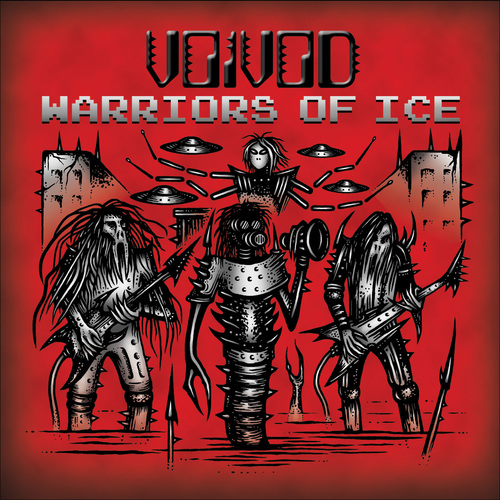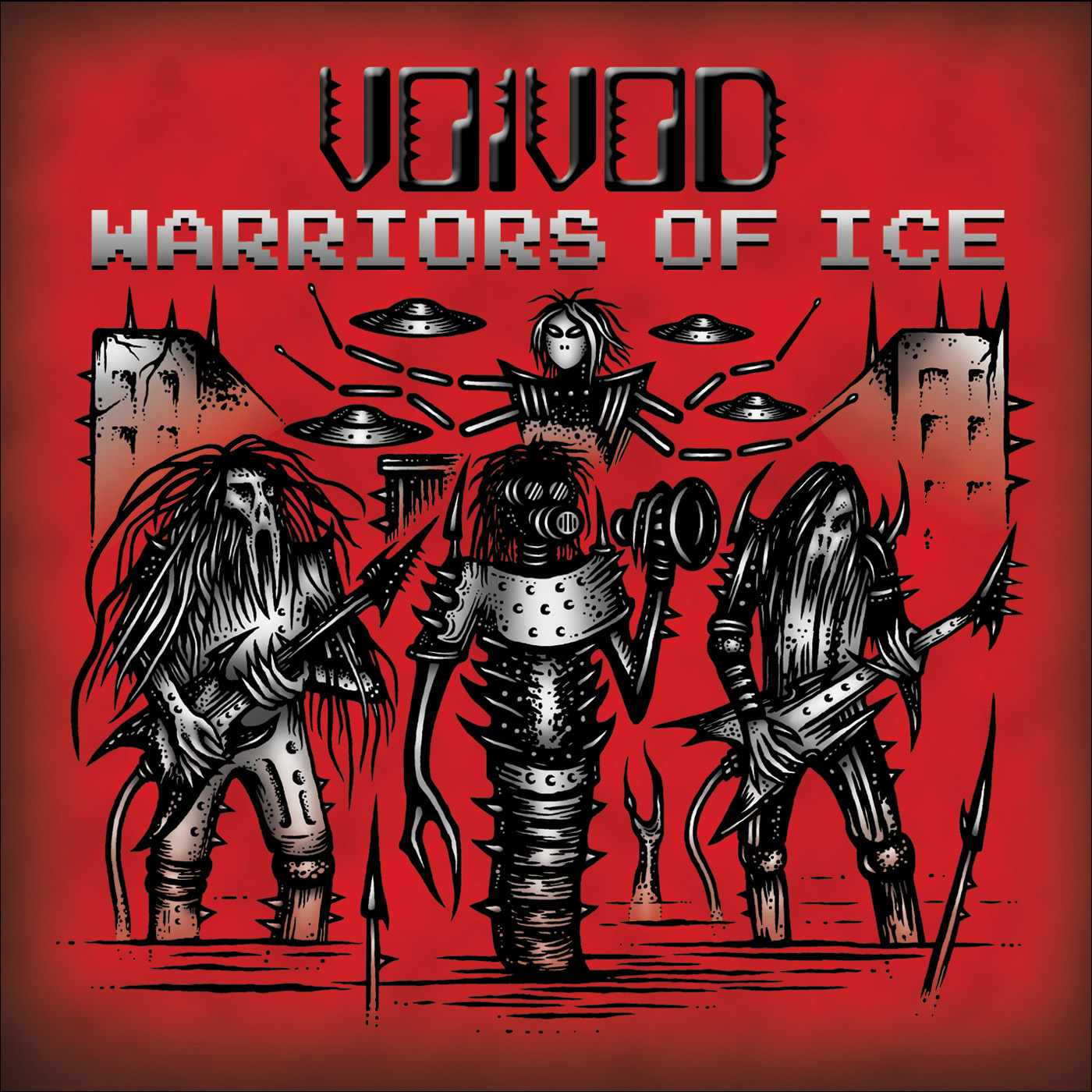Voivod
Biography
Anomaly. Seminal. Iconoclasts. A “band’s band”. These are the nebulous words that sum up a group of artists now in their third decade of collaboration and creation. These terms are yokes that Voivod must bear. Yet there is a purity in this fate that will live forever.
What were the odds in the first place? Four young men in Quebec, addled by art, high on hash, fueled by Venom and Motorhead. Post-heavy metal, pre-MTV. The 80s were upon them and the threat of nuclear war seemed almost inevitable. Why not live out the endtimes sipping absinthe, writing music, and donning leather and spikes?
Michel Langevin conceived a universe, a character, an anti-hero; The Voivod. Dressed in fanciful garb woven by Bram Stoker and Stanley Kubrick, the Voivod was a vampire lord in a post-nuclear age. Immortal and unstoppable. The ultimate goal of any artist. Michel chose to take on the powers of his creation by breathing life into the Voivod’s universe. By creating a musical vehicle for the Voivod’s saga. By starting a garage band.
Denis D’amour provided the music. The young man nicknamed “Piggy” composed a debut album of brutal power, metallic ferocity, mad jazz-shifts, and brash noise. He also began to develop an almost lunatic style with his chords, solos, and tones that combined the technicality of Robert Fripp with the lumbering heaviness of Tony Iommi.
Piggy worked hard to develop “Away”, “Blacky”, and “Snake” into a formidable unit. And he succeeded. Local shows and early tape trading led to interest from labels as far away as Los Angeles. Brian Slagel used his independent label Metal Blade to discover and develop important underground artists like Metallica, Slayer, Celtic Frost, …and Voivod. Compilation tracks led to contracts and a modest budget allowing for time in a Montreal 8-track studio. The first Voivod album War and Pain was recorded and released unto the world in the prophetic year of 1984.
More albums followed and tours too. Voivod began to find a worldwide fanbase of rabid metalheads who couldn’t get enough of the violent sound on War and Pain and it’s follow-up Roooaaarrr. Away painted graphic images of future warriors and weaponry to adorn the covers of these records that matched his lyrical concepts. Snake hideously sputtered these words, shrieking over the “blower bass” foundation laid by Blacky.
A successful U.S. tour in 1986 with Celtic Frost led to greater interest, and greater vistas. Combat/Noise records signed Voivod and sent them to Berlin to record with Kreator producer Harris Johns. As the band aged and grew, so did its abilities and ideas continue to develop exponentially. The third outing Killing Technology was a paradigm shift beyond its predecessors that nearly no one expected. Now the Voivod character was a cyborg in outer space that had survived multiple nuclear wars and was prepared to take on the tyrrany of a totalitarian world. More sophisticated lyrics demanded more intricate music, which the band was now competent to provide thanks to their many travels. But listeners were not spared an ounce of brutality. Sharper focus. More deadly riffs. An evil sound commenced that to this day is as alien and effective as it was in 1987.
MTV and the music industry at large could not ignore the thrash metal demographic any longer. Too many records were being sold and too much money was going directly into the underground scene that could be turned into larger corporate dollars. Even independent, progressive bands were encouraged to streamline their look and sound. Whether you want to call it “selling out” or just refer to it as “general improvements”, it was a fact of life for any band on the cusp of quitting their day jobs to make music for a living.
Album four – Dimension Hatross arrived with the best sound production of any ‘Vod album to date, and a surprisingly tuneful performance by Snake. Add these interstellar harmonies to the barrage of vintage guitar sounds, unrelenting double-kick drum, and a concept that took the Voivod to a microgalaxy of his own creation, and you find yourself listening to a masterpiece. Over and over again.
Even with the anti-entropic rising popularity of each release, Voivod still were far from a household name. The macro-solution to this mega-problem? Sign with MCA for three records and a commercial apex that may never come again. Nothingface became the bands best and best-selling album, featuring flawless digital production, a newfound restraint in tempos and arrangements, and a more thoughtful, poetic lyrical approach. If you have not heard Voivod, this is the place to start.
The tours that followed became the stuff of legend. A support slot for Canadian metal arena heroes Rush. A stateside club tour with newcomers Faith No More and Soundgarden. A constant rotation of the album’s first single “Astronomy Domine” (a tour de force reworking of the Syd Barrett/Pink Floyd classic) on MTV’s Headbanger’s Ball didn’t hurt either.
But after such dizzy heights are so nearly reached, a fall becomes inevitable. By 1991, there was pressure for Voivod to be better yet. MCA’s definition of better was to cut out the most demanding elements, tone down the metal, and work with a name producer. During the Angel Rat sessions, tensions flared. The opportunity existed for Voivod to create a masterwork which might move their music into a new field entirely. From progressive metal to progressive rock. The Voivod character had been abandoned, and so had many of the most recognizable elements from previous albums. With the right combination of events and people, this might have been an album to rival Nothingface which was so unique and perfect and uncompromising. But, not unlike Brian Wilson’s failed attempt to create a masterpiece of Smile, that combination of events did not transpire.
Blacky quit the group, ending a stunningly artistic first period in the group’s history. The following album “The Outer Limits” and its tours would require session bass players to fill the gap he left.
The Outer Limits succeeds in all of the areas in which Angel Rat failed, except for one: nothing ever broke the band to a mainstream audience. Chalk it up to internal and external pressures, the dual ghettos of the prog-rock and metal crossroads where the Voivod dwelt, and the untimely explosion of Grunge and Alternative. It was all these elements and more that created a band more resigned to its fate. That realization, along with a healthy severance budget from MCA, made it possible for the band to create a lasting work of art, possibly its last for a corporate sponsor. From the jagged crush of “Lost Machine” to the 17-minute opus “Jack Luminous”, The Outer Limits is a rich jazz/metal journey into psychedelic spatial realms, that manages to retain melody and pop sensibilities without compromise.
Silence yawned over the Voivod camp for some time. Their “Iron Gang” fan club had long since disbanded. Founding member and vocalist Snake had departed after the TOL tours, despite evidence of a growing audience of Angel Rat fans who were beginning to discover the rest of the band’s catalog. Away and Piggy were left holding the reins of their creation. But truly, Away was responsible for the concept, the artwork, the drive. And Piggy wrote much of the music. By the mid-90s, an underground metal scene was brewing once more. A scene for which Voivod was as influential and responsible as their metal heroes had been to them.
Enter Eric Forrest and Slipdisc records. The best solution for filling two vacancies? Hire one man. Forrest’s abilities on the 4-string as well as the strength of his voice provided the perfect match for a leaner, hungrier Voivod. With digital recording costs dropping throughout the industry, independent money for a record became a viable solution, particularly for a trio with more direct ambitions. Negatron was not an album so much as an experiment. Michel “Away” Langevin, Dennis “Piggy” Damour, and Eric Forrest went in the studio without a concept, and jammed. The results were cruder and more aggressive than any previous recording, yet retained a sonic excellence and truly modern sensibility that placed them less in the prog-metal camp, aligning the group closer to groups like Neurosis and Brutal Truth.
Extensive Negatron tours followed, and the world began to realize that the Voivod still lived. Forrest was capturing the nuances of Snake’s vocal style, while alternatingly flooring or alienating fans with his own death metal approach. What subtlety from the MCA era had been lost was more than balanced by the returned aggression from the Noise years. Now it was time for the Voivod to return.
Phobos woke the creature from its nothing-faced slumber; pitting him in a global war. Even heavier than Negatron, this record blankets the listener in a cloud of analog sound, thick and almost stifling. More psychedelic than Angel Rat, heavier than Killing Technology, Phobos was a Dimension Hatross for the 90s and the most vital work the band had produced since Nothingface.
Fate struck one more blow when a tire blow-out turned the tour van over on the German slopes of the Phobos tour. Eric Forrest was nearly killed, surviving to endure multiple major surgeries, and permanent injury to his legs and back. Amazingly, Eric weathered rigorous rehabilitation and physical therapy, and recommenced Voivod tour with co-headliners Neurosis and support compliments of Today is the Day. Eric sang, played bass, and walked with a cane to be in the band he loved.
But to the dismay of some (and the relief of others), Eric eventually was asked to stepped down.
A new light and life entered the Voivod camp. Snake returned to sing after a seven year hiatus and the aborted Union Made project. Longtime friend and fan Jason Newsted (ex-Metallica) did bass & production duties on the Voivod’s next three studio albums.
Due to his visibility with Metallica (and temporary membership on Ozzy Osbourne’s band), Jason Newsted helped Voivod achieve new found visibility and helped the band secure a slot in 2003’s Ozzfest where the band probably played for the largest crowds ever.
As the band worked on their 14th album, disaster struck VOIVOD again. In the summer of 2005, guitarist Denis “Piggy” D’Amour was diagnosed with colon cancer, and as he entered the hospital for a routine operation, several complications led his doctors to find out that his cancer was inoperable, as it was too advanced and had already spread to his liver. Denis slipped into a coma on Thursday August 25th and died less than 24 hours later in the palliative care unit of a Montreal hospital, surrounded by family and friends. He was 45 years old.
The band chose to use the guitar demos Piggy had recorded for the new album, and finished and released the recordings as an album titled Katorz, as a tribute to the guitar genius.
On 2009, the band used other unreleased guitar demos Piggy had recorded and built a new album around them, with the help of Nothingface’s producer Glen Robinson. The album was titled Infini.
After Piggy’s passing, and despite the almost certainty that Voivod’s story as a band had come to an end, some reunion jams in 2008 with original bassist Jean-Ives Theriault and Martyr guitarist Dan Mongrain, led to the band to start touring again as Voivod. As some touring opportunities were offered to the band, they did some major touring in 2008, 2009 and 2010, playing in the USA, Europe and Japan, and releasing the Live DVD Voivod Tatsumaki Voivod Japan 2008.



















